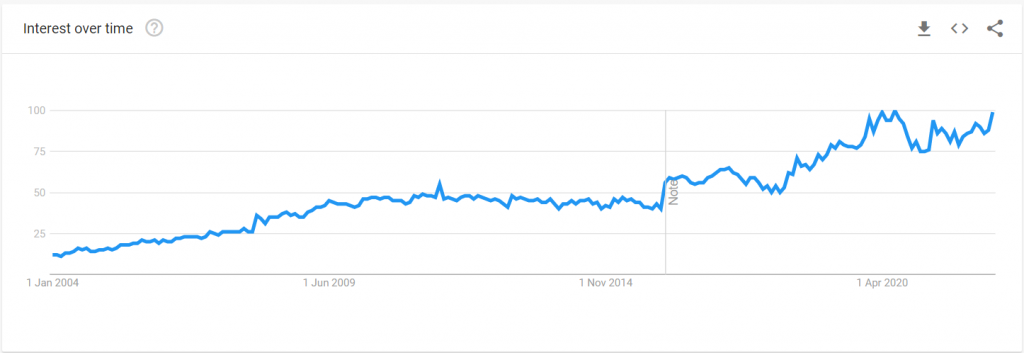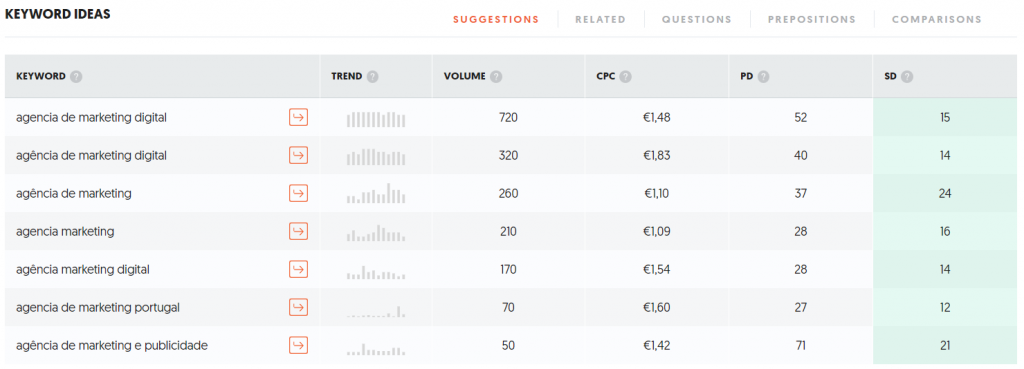A guide to SEO
SEO: What is it and how important is it?
According to according to statistics from
Google Trends,
dsince 2014, interest in the term“SEO” has been increasing at a steady pace.
.
This results from the growing need of companies to hire professionals in the field of Digital Marketing.
While there are a variety of positions in this area, SEO-related positions, such as SEO manager or SEO specialist, are the ones that have been in high demand.
That said, it is important to understand what this acronym means and what its importance is today.

What is "SEO'' anyway?
SEO is an English acronym used to designate “Search Engine Optimization”. Translated into Portuguese this means “optimization for search engines”.
It is one of the most important components of Digital Marketing as it directly influences our position in the search results pages(SERP).
More explicitly, SEO aims to increase the visibility of our web pages, either through:
-
- on-page optimization (referred to as “on page” SEO);
- off-page optimization (known as “off page” SEO).
A complete SEO strategy should make use of these two types of optimization.
It is important to note that SEO only concerns organic traffic.
There is also the component of SEM (“Search Engine Marketing”) but this concerns search engine optimization using paid traffic.

When we search for a term on Google we can see that the first results are mentioned as “ad”. Organic traffic will only appear after paid results.
Why is it so important to have content optimized for search engines?
According to the latest data, the top 5 results on the 1st page of Google receive approximately 68% of all clicks.
So, if most people doing an online search won’t even see the 2nd page of Google results, it’s crucial that you appear on the 1st page!
Imagine this example: you have a cooking blog and you have just published a recipe for chocolate cake.
If this content is not optimized for search engines, you can be sure that hardly anyone will reach your recipe and take notice of your blog.
What factors determine your positioning?
There are several factors that influence the positioning of our web pages. Here we will share with you the ones we consider to be the most important.
Relevant and quality content
You should focus on writing content that is relevant to your target audience. That is, content that meets what they are looking for.
First try to understand what people are looking for when searching for a keyword you are interested in using.
For example, if you search for “coffee” on Google the first results talk about the benefits of coffee, so it makes more sense to create content on this topic. However, if the first results mentioned “What is coffee?” it would make more sense to publish content about the meaning of coffee and its origins.
If your content is relevant and of good quality, visitors will feel encouraged to stay on your site and visit other pages on it.
Choosing the right keywords
There are several tools that allow us to see which keywords we should use in our content, such as “
keywords everywhere
” and “
Ubersuggest
“.

However, it is not enough to choose the keywords that have the most monthly searches. We also need to understand whether it makes sense to use them for our business.
If we have an online clothing store and our tool says that there is a high demand for “laundry” it probably doesn’t make much sense to publish content about this term because we will most likely attract people looking for a solution to their laundry and not visitors interested in buying our clothes.
Optimize html components
The HTML code will also need some changes if you want to get the most out of SEO. But don’t worry, you don’t need to know code, it’s much simpler than it looks.
Here are the components you need to look out for:
-
Title tags
: this is the title that appears on the Google results page. You should make sure that you put the main keyword you want to rank for here and that your title is catchy.
Meta description
: this is the section that appears after the title tag. This should include a short description (no more than 230 characters) of what users will find on this page, with your main keyword.- Alt text: is the text that describes your images. In case they do not load, it is this text that will be visible. The alt text should be short and contain the keyword you want to rank for. Example: “54825.jpg” – ❌ / “dicas-uteis-seo” – ✔️
Headers
The headings of your article, known in HTML as H1, should contain your keyword and encourage visitors to read the content. You should only have one H1 but you can have several H2, H3 and H4 (subheadings).
URL’S
: the URL corresponding to your page should not contain random numbers and/or letters, but a very short description of what visitors will find on your page. Example:
http://getvalue.ptredes-sociais/
Get quality backlinks
What is a backlink? Put simply, it is a link placed on a page with the purpose of redirecting traffic to another page.
One of the most important SEO factors is the amount of backlinks your site has.
However, it is not enough to have several links redirecting to your website. The quality of these matters: the higher the authority of the domain and the page that posts the link, the more valuable these backlinks are.
If a page that is considered “spam” in Google’s eyes redirects people to my site, I will get the opposite of the intended effect, and it will negatively affect my site in terms of SEO.
Although not as powerful, it also helps to have internal backlinks (links that I place redirecting to another page on my site) as it helps the visitor to get the information they need only on one site, which will also improve our bounce rate.
Other factors to take into account
Your website should:
-
- Be mobile-friendly: when visiting our website on a cell phone, the user-experience (UX) should be as good as on desktop.
- Have a good UX: be responsive and easy to navigate.
- Fast loading of all pages.
These functionalities can be evaluated using
Google Search Console
.
For now, these are the tips we have to share with you.
Now that you know how to use SEO, you have no excuse not to appear in 1st place in search results!
Remember to use all these strategies together and not rely on just one, because if you do, you won’t be making the most of your web pages.
If you are interested in learning more or need help developing an SEO campaign, please contact us via e-mail: info@getvalue.pt or via our telephone contacts: 210 938 301 / 910 727 848.


